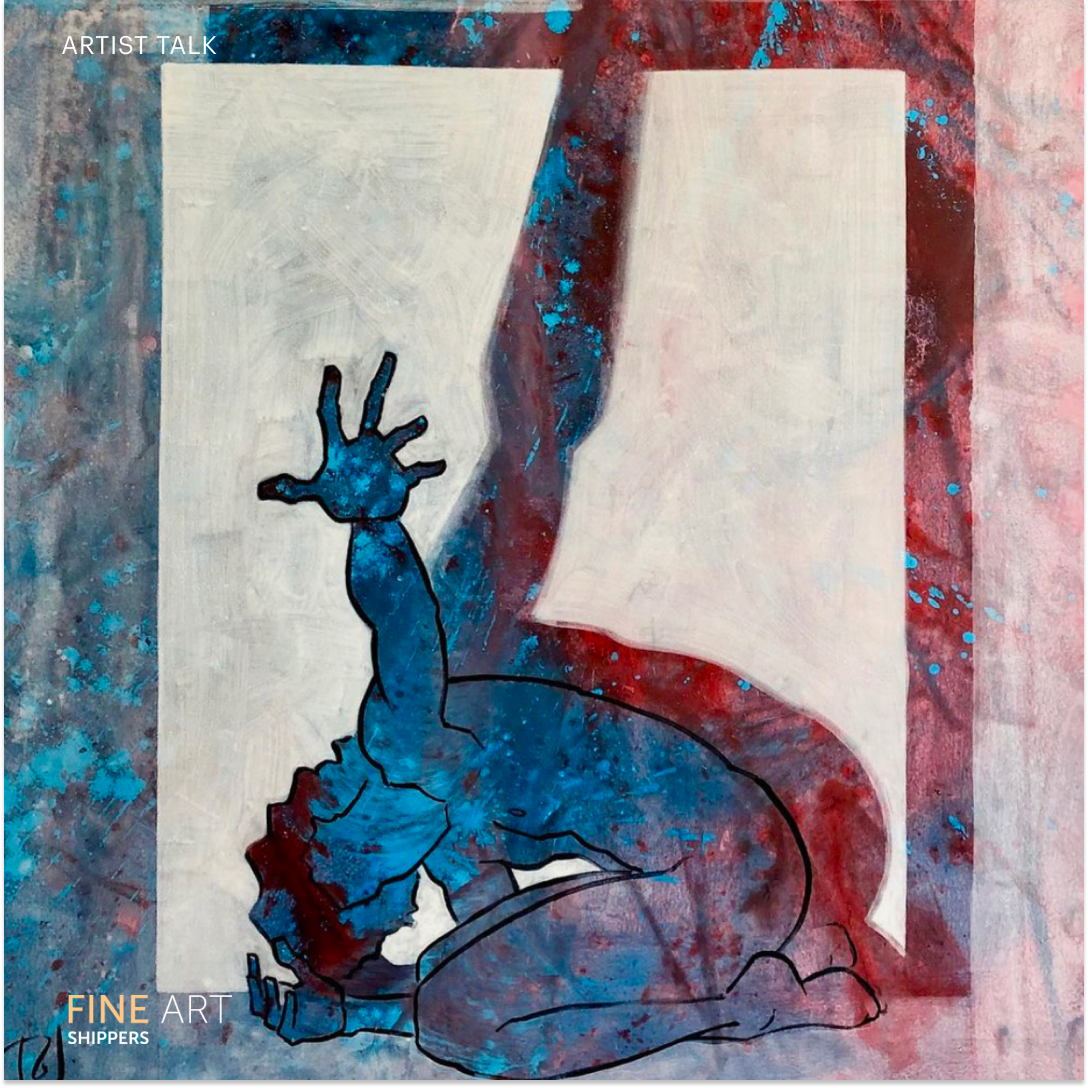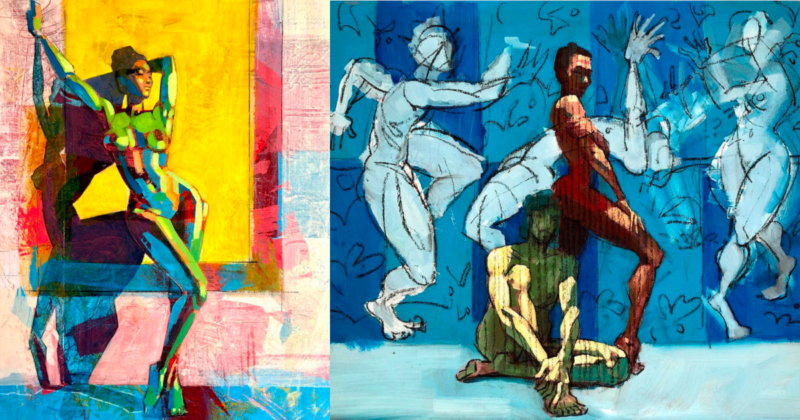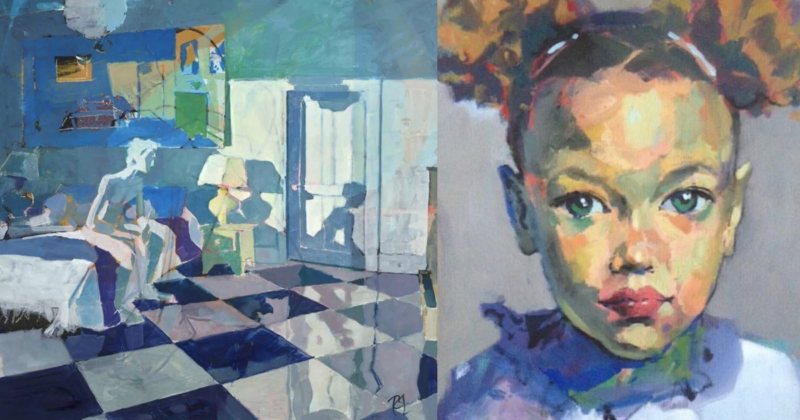Toby Mulligan is a contemporary British artist whose works have garnered critical acclaim and the admiration of art collectors. His expressive works, in charcoal, ink, and paint, are rooted in improvisation and the physicality of the creative process. In an interview with Fine Art Shippers, Toby Mulligan shared his thoughts about the essence of art, the passage of time, and sensory experiences.
Artist Talk: Toby Mulligan on Feeling and Being Alive
I would like to begin by discussing the message you seek to convey through your paintings. What is it that you want people to see and understand when they interact with your art?
Toby Mulligan: I don't aim to convey any message through my paintings. I seek to connect with what's inside me and just be present in the moment. I think that feelings are essential for all people. I try to follow my natural curiosity. I find inspiration in life: light, shadows, smells, everything I can experience through my senses.
So for you, art and the artistic process are a sensory and sensual experience through which you try to understand the world?
In a way, yes. Although, again, I'm not trying to understand. I focus on being aware of myself as a human being and use my body and mind as tools, perhaps not in the strict sense of the word, but more like observing a scientific experiment.
It's about pure observation, which has an aspect of meditation to it. I try to live in the moment, staying alert, lucid, and fully alive to all the sensations that surround me. When I paint a landscape, for instance, my goal isn't just to create a visually appealing image. If there's any aim at all, it's to truly experience that moment and translate my feelings.
To me, it's a sensual experience, but I want to convey it in an immediate way, free from excessive intellectual interpretation. This is a message in a way. We, humans, possess consciousness, but we don’t always know how to use it. As a result, we create problems for ourselves. Most of them come from not being fully alive and clinging to rigid ideas that we mistake for reality. We often consider our ideas to be the absolute truth and don’t realize that they exist solely in our minds.
When painting a landscape, do you prefer to be on-site, experiencing it firsthand, or do you recollect those feelings from memory?
I really prefer to be there on-site. Being in the actual environment allows me to be guided by the changing fleeting light, sudden rain, things like that. They keep me grounded and connected to the moment.
When I'm in the studio, I have too much control over the creative process, which leads to overthinking. That’s why I deliberately create challenges for myself, like painting with both hands, to stay focused and avoid getting lost in my thoughts.
I want to be always in tune with my body and surroundings, whether I'm outdoors or in the studio. Comfort is a killer of creativity. For me, the true magic happens when I push myself beyond my comfort zone while staying connected to the physicality of the creative process. That's when art truly comes alive.
I'm curious about what you said regarding painting with both hands. Can you use both hands with equal dexterity?
The very word, "dexterity," is interesting because it originates from the Latin word “right.” My hands are not equal in dexterity but they seem to communicate with each other. One technique that works for me is painting with both hands simultaneously, sometimes even creating two different things at once. This practice gets me into a zone where my body and mind are in complete coordination, and I feel both relaxed and alert. It's not easy, but setting a timer and doing a large number of drawings in a short time, with both hands, can release inhibitions and open up creative freedom.
I would like to discuss the portrait of your daughter titled "About Time," which is displayed in the National Portrait Gallery. In your Facebook post, you mentioned that the portrait captures your child as the embodiment of fleeting time. Can you elaborate on that?
When I painted "About Time," my daughter was very young, and the difficult relationship with her mother made it hard to spend time together. However, things have changed, and we now see each other a lot more frequently.
This painting is special to me. When I was working on it, I felt like I did not have enough time to make that important connection with my daughter. I had to paint it quickly because time was limited, but that urgency added depth to the artwork and made it better in many ways.
As an artist and a human being, I always want to live in the moment, purely creating art. But, of course, life comes with responsibilities like paying bills. For a long time, I struggled to make a living from painting so I worked as a builder, and it was about time that I changed that. I had to face the world and stop hiding away my art.
It was a personal journey to put myself and my work out there, offering my art to be judged and liked or disliked by others. This process can be tough, as not everyone may appreciate, like, or understand my work, but it's an essential part of being authentic and sincere as an artist.
So tell us about your journey to becoming an artist.
I’ve always painted but in my family art wasn’t considered something that could earn you a living. My main battle was an internal struggle to accept myself as an artist. In my late thirties, I decided to make a change — and then around 2015, I started to approach galleries and put myself out there as an artist. The battle didn't end with self-acceptance; I still struggled with the idea of deserving money for my art. However, once I took the leap, things moved quickly, and today I wonder why I didn’t do it sooner.
Interview by Inna Logunova
Photo courtesy of Toby Mulligan



